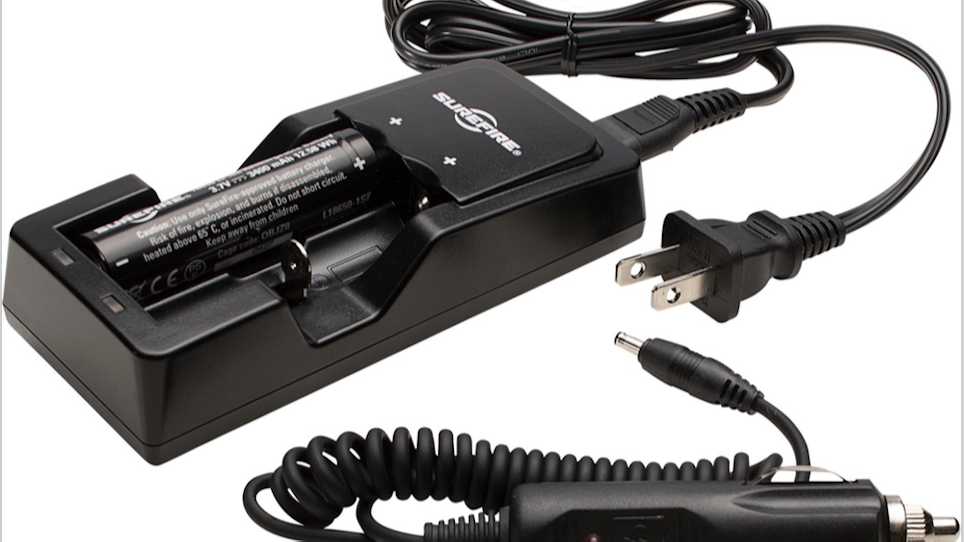If you're a fan of lithium batteries, the SureFire lithium ion rechargeable battery and charger is super to have in a vehicle for emergencies and on-the-go charging.
We rely heavily on electronics for our day-to-day existence. Cellular devices have replaced phone, computer, library and GPS with a single piece of equipment. It’s no wonder that military, police, preppers and outdoorsmen want to use these devices no matter where they are located.
Wherever you are located requires electrical power, and you’ll need to assemble a mobile power system that consists of power sources/collection, power storage, power transfer and a way to manage and distribute the power collected.
When assembling a power management system, the first thing to do is take stock of your devices to determine what form of electrical power they require and how much of it you’ll need. For instance, what type of batteries or plugs? Do they need AC or DC power, in 110v or 220v? How long do you need the devices to run? Build everything around that.
Power Sources
Shore Power is generally considered the most reliable source of electricity. The existing power grid is certainly convenient. When possible, use it, even if to charge batteries. In some cases, the power grid may not be available, or may deliver out-of-phase power or spikes. In those cases, it will require conditioning before use.
Fuel
These include generators, which are motors used to create electricity. They are available in a wide variety of sizes but are generally fuled by what the military refers to as MOGAS (motor gasoline). This is the same fuel used in most civilian vehicles. The military has introduced diesel generators as they switch to JP-8 as a common fuel because it is more stable and can be used in aircraft.
In recent years, we have seen a new class of generators referred to as multi-fuel. Some will accept both MOGAS and diesel, while more exotic models accept alcohol fuel and even fingernail polish remover. While all generators require maintenance, these understandably require more than most. Aside from maintenance, generators can also be noisy.
Vehicle Power
Vehicle electrical systems fall in line with shore power and generators. Devices may be wired into the vehicle via a mount, or plug into a receptacle (cigarette lighter or 3-prong). A vehicle offers battery power that can be recharged while the vehicle is running as well as direct power to any devices while running. Unfortunately, like a generator, the vehicle will generate a noise signature.
Solar
Solar panels are actually photovoltaic panels that convert light energy into electricity. They constantly become more efficient as newer models are introduced. They may be rigid or flexible in form. Many are reflective while models developed for military use have a matte finish to mitigate shine.
Wind/Gravity/Hydro
Wind generators are great, so long as there's wind. Unfortunately, they are labor intensive to install, and have a large visual signature. Gravity/Hydro powered power generation makes use of streams and rivers to turn a turbine that is used to generate electricity. However, these are only useful in very specific circumstances.
Human Powered
For decades in the military, we relied on hand-cranked generators to recharge batteries. Even today, hand-cranked radios and flashlights are popular for use during natural disasters. One advantage to adding these to a 72-hour kit is that there's no need to store batteries separate from the device.
Storage
Electrical power is stored in containers called power cells, which make it usable when and where we need it. They take several forms:
Battery —an array of galvanic cells for storing electricity.
Electrochemical cell — a device that generates electricity from chemical reactions.
Fuel cell — an electrochemical energy conversion chamber using reactants.
Generally, batteries are readily available and relatively inexpensive. But remember, not all batteries are rechargeable. The most common commercially available rechargeable batteries are currently lithium ion. A general rule of thumb is to store batteries separate from the device they'll be used in and store them in a cool, dry space such as a refrigerator.
Management
We now come to what is the most overlooked component of a power system and that is power management. When harvesting, storing and using power, you must know how much power you have, how it is being used and how you distribute it.
In a scenario where you must power multiple devices, you may need to provide different types of power. While there are dedicated items on the market that automatically detect types of batteries and devices they are connected to, something as simple as a voltage meter and set of probes may suffice for rudimentary use.
Cabling
Regardless of which types of power cell you use, you need to ensure you have the proper cables to transfer power from the source, to the batteries and eventually to your devices.
A power management system may be as simple as a few rechargeable batteries with a plug-in charger, or as sophisticated as a full system complete with cabling, solar panels and a wind generator. Regardless, it is all based upon the electronic devices that require power.







